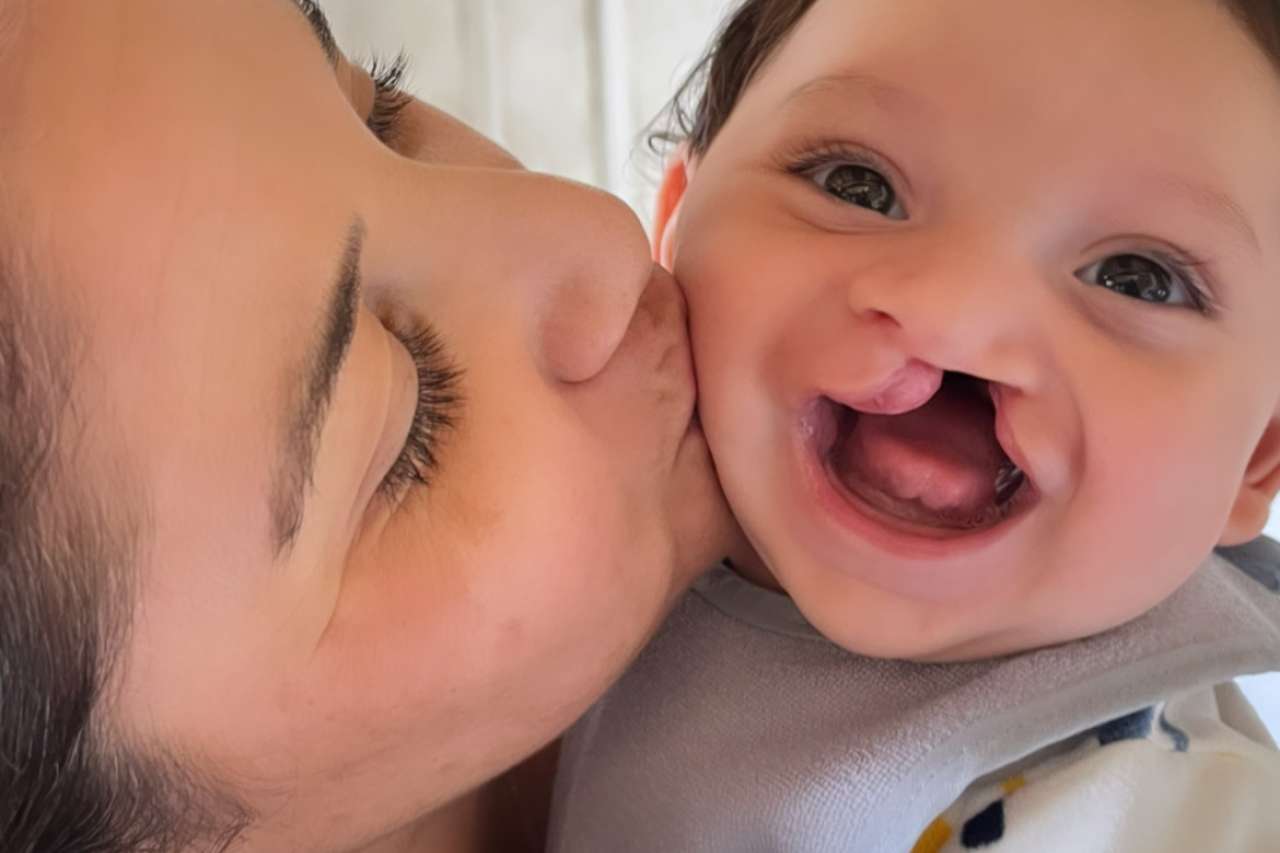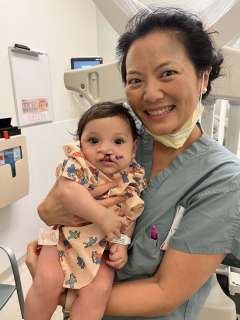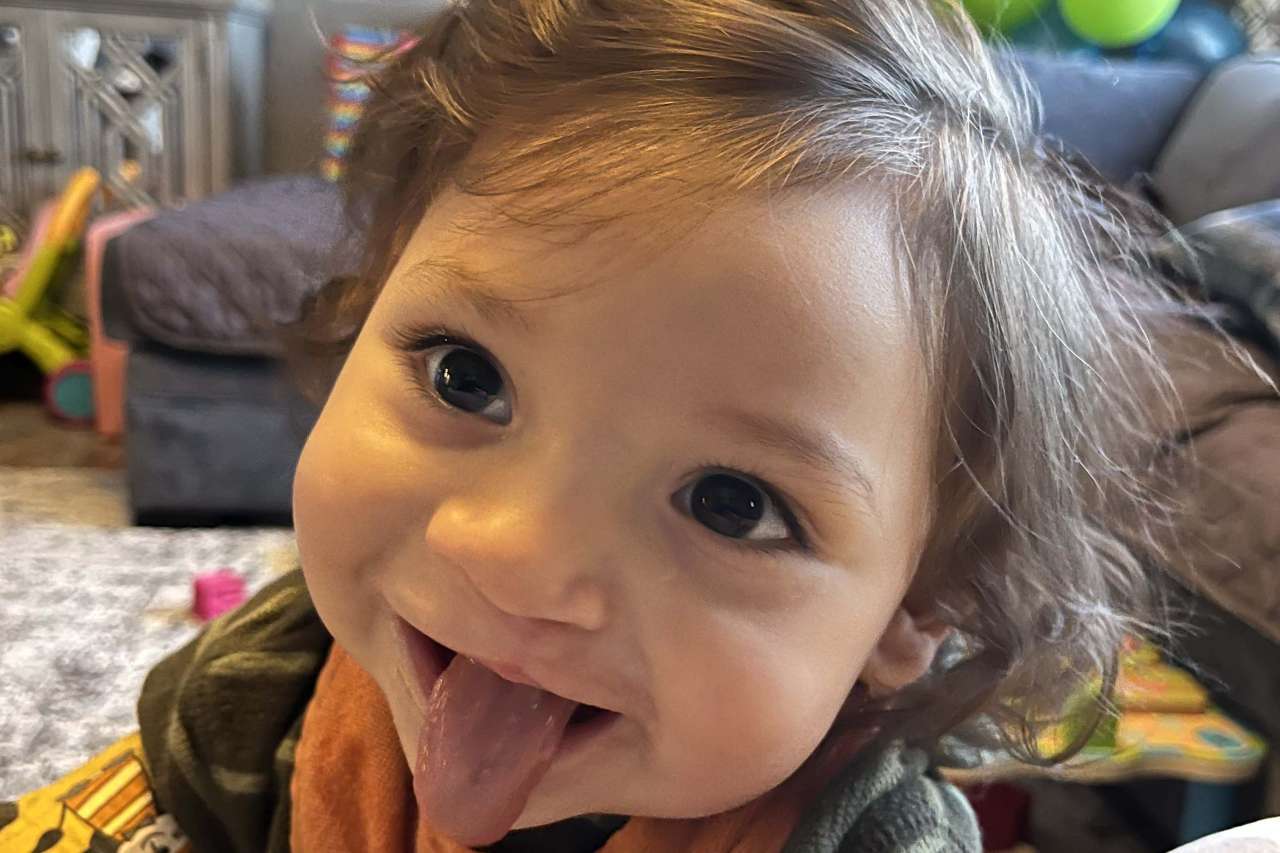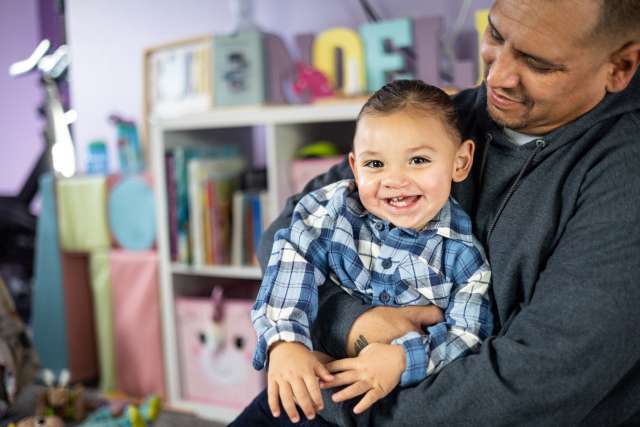Even before Kane’s birth, his parents, Jill and Stephen Contreras, knew he’d have a cleft abnormality. “Going in for a 20-week anatomy scan and coming out with the news that your unborn child has cleft lip/palate can really turn your whole world upside down,” Jill Contreras said.
There were still unknowns, as the extent of the cleft issues couldn’t be assessed until he was born. But Kane’s parents immediately began to prepare, including lining up care from UCLA Health’s pediatric craniofacial care team.
In the weeks leading up to Kane’s birth, Jill Contreras reached out to other parents of children with cleft issues to learn more about what would be in store. Kane would have specialized feeding needs, she learned, and would require several surgeries, including not long after birth.
Because Kane would have difficulty latching and achieving suction, breastfeeding was out; instead, he’d need specialty bottles and nipples designed for babies with cleft issues.
She learned that she’d have to hold his bottle at a special angle to avoid the cleft opening in his mouth, and that Kane would “chomp” on the nipple, which had a back-flow prevention device so that the liquid would then stay in the nipple so it could gently flow into his mouth rather than having to be sucked in.
Then, once Kane was a few months old, he’d be able to have his first surgery, which would make it easier for him to latch on. The surgery generally isn’t done until that age, given the potential risks of general anesthesia.
Two surgeries during his first year
Cleft lip (either alone, or with a cleft palate) occurs in about one in every 1,050 babies, according to the Centers for Disease Control and Prevention. The clefts can occur in the lip and/or the palate, and can be on one side or both.
In Kane’s case, it was difficult to get a clear scan of his face during the ultrasounds Jill Contreras had during her pregnancy. But when he was born in February 2023, he was diagnosed with both a cleft lip and a cleft palate on the left side, extending into his left nostril.

Even with the specialized bottle, “feedings were so hard,” Jill Contreras recalled. “He wanted to eat, he wanted to suck that bottle down, and he couldn’t.”
Because Kane’s cleft was the left side, she’d angle the bottle so he could use the gums on the right side of his mouth to chomp on the bottle. “Eventually we both got it down so I knew which way to slant it, and he would start eating and we would just stay like that.”
The feeding sessions were arduous, she recalled, with Kane typically only able to drink about 2 ounces at a time.
At his first appointment at UCLA, when he was 2 months old, Kane and his parents met with several members of the multidisciplinary cleft clinic team, including a pediatrician on the team, Irene Hendrickson, MD, director of the UCLA Craniofacial Specialty Care Center and the course chair of pediatric medicine in the UCLA School of Dentistry.
They also met with Monica Jones, AuD, the primary audiologist for UCLA’s Craniofacial Clinic, and with Justine Lee, MD, PhD, a craniofacial and pediatric plastic surgeon at UCLA Health and the Bernard Sarnat chair of craniofacial biology in the Division of Plastic and Reconstructive Surgery at the David Geffen School of Medicine at UCLA. Dr. Lee instructed Kane’s parents on how to begin taping the two sides of his upper lip together using surgical tape, which helped somewhat with the feedings, she said.
Finally, at 3 months, Kane was considered old enough for the first surgery, to repair the cleft in his lip.
“The goal is to bring the lip together,” said Dr. Lee, who performed the surgery.
“When the lip is clefted,” she explained, “the muscle that goes around your mouth that helps you form a ring and close your lips is clefted too. So, the functional part is to put that muscle together.”
That first surgery also included some surgery on his nose, Dr. said.
“Anytime you’re born with a one-sided cleft, the septum is deviated,” she explained. “We do a little bit of nose adjustment for some symmetry, but we typically don’t do anything definitive to straighten the septum of the nose until they’re teenagers when they’re done growing, as the septum is a growth center.”
For a week after the surgery, Kane had to wear arm restraints so he couldn’t touch his face, and Contreras had to use a special syringe rather than a bottle to feed him. But after that initial week, he started drinking 4 to 6 ounces at a time, rather than 2, Contreras said, and was also able to do so more quickly.
For the next several months, Kane continued with his bottle and also started eating solid foods, under the guidance of his occupational therapist. Because of the opening in his palate, some of the food would come out of his nose, Jill Contreras said, although it didn’t seem to bother him.
Then, in February 2024, just before his first birthday, Kane had a second surgery to repair his palate by closing the gap in the roof of the mouth.

“Just like the muscles of the lip are split, the muscles that are in the palate are also split,” said Dr. Lee, who performed this surgery as well. This included repairing the muscle that elevates the palate (the levator veli palatini muscle). “That muscle is important for feeding and speech,” Dr. Lee explained.
During the surgery, Kane also had pressure equalization ear tubes inserted into his eardrums by Alisha West, MD, a pediatric head and neck surgeon at UCLA Health and associate clinical professor of head and neck surgery at the David Geffen School of Medicine at UCLA. Because of the clefted palate muscles, the Eustachian tubes that connect the ears and the throat often don’t open fully, allowing fluid to accumulate, Dr. Lee explained. The tubes help open the ears to allow for drainage of the fluid, which can otherwise lead to infection and may also affect hearing, which in turn affects learning to speak.
Again, Kane had a week of arm restraints and syringe-only feeding. But since then, “he’s been doing great,” Jill Contreras said. He continues to see an occupational therapist locally to help with feeding and also sees a speech therapist at UCLA.
A few more surgeries down the road
Unlike what is frequently portrayed in popular media, cleft care has a number of stages beyond just the lip and palate repair. Kane still has a cleft at the alveolar ridge, which is where the teeth grow in. This opening will remain until he’s about 7 or 8, at which point he’ll require a bone graft from his hip to repair the alveolar cleft and to allow his teeth to grow into the clefted area. With a cleft palate, “there’s a cleft in the bone too,” Dr. Lee explained. Without adding bone to repair the cleft, the upper jaw is collapsed and there is no way to align the upper teeth to the lower teeth, which poses difficulties in the mechanics of chewing food.
To prepare for the surgery, Kane will see a specialized cleft orthodontist when he’s about 6 or 7, and fitted with a palate expander that will gradually widen the arch in his upper jaw, said Dr. Lee. After his palate has expanded enough so that the upper set of teeth are aligned on top of the lower teeth, bone from his hip will be transferred into the alveolar cleft.
The bone to fill in the gap in the upper palate, which will be harvested from Kane’s hip, will fuse with the bone that’s already in his upper jaw.
Because the palate expander is fitted onto the adult teeth, the timing will depend on when Kane’s adult teeth start to grow in, Dr. Lee said.
“The main point of that surgery is to allow him to complete his orthodontic care,” she said. “Teeth in cleft kids are very complex – they grow only where there’s bone, but there’s no bone where the cleft is.”
Once the new bone is in place and the upper and lower set of teeth are aligned, the remaining teeth can continue to emerge, she said, and the jaw will also be better aligned for chewing.
Kane will likely have one more surgery once he finishes growing, Dr. Lee said. If his upper jaw doesn’t grow forward as much as his lower jaw does, he may need a surgical procedure to correct the resulting underbite, which otherwise can cause functional issues including difficulty chewing.
In this scenario, he’d have the surgery once he’s between 18 and 21, she said, and the additional procedure to finish correcting his deviated septum would take place afterward.
If the additional jaw surgery isn’t necessary, Kane can have his deviated septum fixed earlier, she said — likely when he’s about 16. Even after the initial procedure that was done when he was 3 months old, “one side of his nose is still a little bit narrower, airway-wise,” she explained, and will be until that second surgery to straighten out the septum so both airways are unobstructed.
Ongoing monitoring and care
Kane continues to see his care team at UCLA Health, including a speech therapist, as well as an occupational therapist and a speech therapist near their home in Oxnard, Jill Contreras said. “Right now, Kane’s working on saying “Dada,” she said, which is harder for him to say than “Mama,” given the placement of the tongue on the roof of the mouth that’s required to make the “D” sound.

He’s also still seen regularly by Dr. Jones, his UCLA audiologist, to ensure the ear tubes remain in place and to continue to monitor his hearing, which can sometimes be affected by fluid build-up.
“The whole team will keep on eye on him all the way until he’s 21 or done with care,” Dr. Lee said. That team includes pediatricians, geneticists, speech pathologists, orthodontists, pediatric dentists, audiologists, otolaryngologists (also known as ear, nose and throat doctors, or ENTs) and social workers, she said. Kane will see additional members of the team as needed if issues come up.
“Up until two years, we want to be sure he has a full team meeting every six months,” said Dr. Hendrickson, the UCLA pediatrician. “One of the things we check on is to make sure the parents have good support and that he’s getting lots of help learning new skills from surgery to surgery.”
After about age 2, depending on how he’s doing with his speech, he’ll probably be seen at UCLA Health once a year, she said.
In the meantime, though, Kane’s personality has already made quite an impression. Even before the surgeries, he was “just the happiest baby – always a smile for everybody,” Dr. Hendrickson said.
And now, thanks to Dr. Lee’s handiwork and the expertise of the entire cleft clinic team at UCLA, Kane has an even more beautiful smile to show off.
“Oh my goodness, this kid,” Dr. Lee added. “He’s just the cutest kid.”



